Accelerate IT operations with AI-driven Automation
Automation in IT operations enable agility, resilience, and operational excellence, paving the way for organizations to adapt swiftly to changing environments, deliver superior services, and achieve sustainable success in today's dynamic digital landscape.
Driving Innovation with Next-gen Application Management
Next-generation application management fueled by AIOps is revolutionizing how organizations monitor performance, modernize applications, and manage the entire application lifecycle.
AI-powered Analytics: Transforming Data into Actionable Insights
AIOps and analytics foster a culture of continuous improvement by providing organizations with actionable intelligence to optimize workflows, enhance service quality, and align IT operations with business goals.
What if the very systems powering your business are the same ones holding it back?
Mainframes have served as the digital backbone of industries like banking, insurance, retail, and government for decades. Their reputation for reliability, security, and massive transaction throughput is unmatched—and that’s precisely why 71% of Fortune 500 companies still depend on them today.
But these systems were built for a different era—one with fewer users, slower change cycles, and predictable demands. Fast forward to 2025, and we’re in a radically different world. Business models are being reshaped overnight. AI is redefining operations. Customers expect instant, hyper-personalized experiences. And your legacy infrastructure? It wasn’t designed to keep up.
A recent survey found that 48% of M&A professionals are now using AI in their due diligence processes, a substantial increase from just 20% in 2018, highlighting the growing recognition of AI’s potential to transform M&A practices.
Consider this:
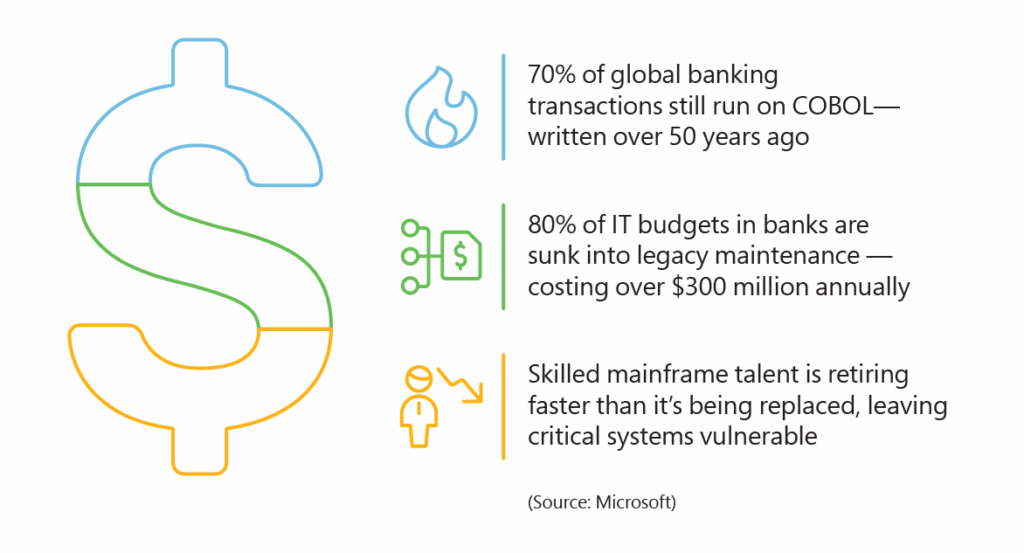
The reality is clear: mainframes are no longer the silent enablers they once were. They’re gradually turning into a barrier that slows down critical digital transformation efforts.
This blog explores everything you need to know about legacy modernization mainframe initiatives, including what it means, why it’s crucial, modernization strategies, and how to overcome common hurdles
What Is Legacy Mainframe Modernization?
Legacy mainframe modernization is the process of updating or transforming aging systems—typically built on COBOL, JCL, or Assembler—into modern, scalable platforms. It’s not just about replacing hardware or rewriting code; it’s about rethinking how legacy systems deliver value in today’s cloud-native, API-driven, AI-augmented business world.
Think of it as preserving mission-critical functionality while unlocking the flexibility, speed, and scalability of modern digital ecosystems.
Whether you’re moving to the cloud (rehosting), refactoring code, integrating APIs, or adopting SaaS, modernization enables:
- Greater agility
- Lower operational costs
- Improved security and compliance
- Seamless interoperability with modern systems
And no—it doesn’t always mean killing the mainframe. Often, it’s about evolving what works and replacing what holds you back.
Why Modernize Legacy Mainframes in 2025?
1.Rising Costs and Technical Debt
Mainframes can cost up to 4,500 USD per MIPS (million instructions per second) per year, depending on workload and licensing structures. The cost of maintaining legacy systems, including hardware, software, and support personnel, is spiraling—consuming up to 60–80% of IT budgets in traditional enterprises (Gartner, 2024).
Technical debt also accumulates as patches and temporary fixes hinder innovation, introduce fragility, and slow down releases.
2.Shortage of Skilled Legacy Developer
Nearly one-third of COBOL programmers will retire by 2030, and younger developers rarely train in COBOL, JCL, or Assembler. The number of skilled mainframe professionals is shrinking rapidly, creating a talent crisis that makes modernization a necessity.
Integration with Modern Cloud and Digital Systems
Legacy systems often act as data silos, hampering real-time integration with cloud-native applications, mobile platforms, and AI engines. Modernization unlocks interoperability through APIs, microservices, and cloud-based databases—enabling digital transformation.
3.Cybersecurity and Compliance Risks
Outdated systems are often not compliant with modern regulatory frameworks like GDPR, PCI DSS, or HIPAA. Patching security holes is cumbersome, increasing vulnerability to cyberattacks. Legacy system
breaches tend to cost around 18% more on average due to slower detection and recovery—according to findings from multiple industry reports.
And let’s not forget the lessons from the pandemic—mainframes exposed limitations in remote access, scale, monitoring, and resilience.
Modernization Strategies: Choosing the Right Path
Gartner recommends using the Tolerate, Invest, Migrate, Eliminate (TIME) framework as a strategic model to evaluate which applications should be rehosted, replatformed, rearchitected, rebuilt, or replaced. This approach aligns business value with technology suitability, enabling enterprises to make informed, workload-specific decisions.
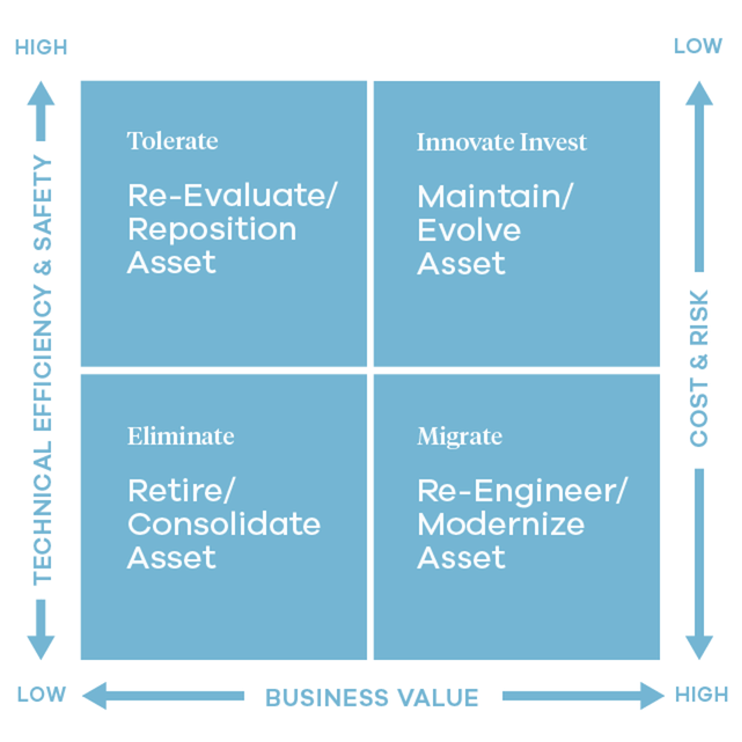
Decision Patterns for Application Modernization
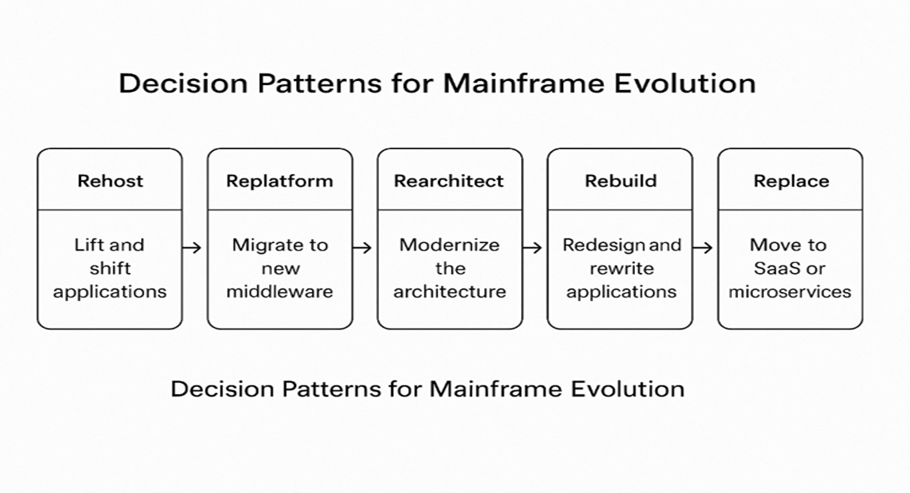
This flowchart helps visualize application modernization strategies based on their business value and technical fit. Use it as a guide to prioritize and streamline your modernization roadmap.
Rehosting (Lift-and-Shift)
What it is: Moving mainframe workloads “as-is” to cloud or virtual servers.
Pros:
-
-
- Fast migration
- Minimal code changes
- Cost-effective short-term
-
Cons:
-
-
- Doesn’t optimize performance
- Tech debt remains
-
Use cases: Organizations needing quick cloud transition without major transformation.
Replatforming (Middleware Migration)
What it is: Moving applications to a modern OS or database without changing core logic.
Pros:
-
-
- Improves performance and scalability
- Moderate risk
- Reduces reliance on legacy hardware
-
Cons:
-
-
- · May need custom connectors/APIs
- · Still tied to old code structure
-
Use cases: Enterprises wanting incremental modernization without full rewrite.
Refactoring (Code Transformation)
What it is: Rewriting legacy code into modern languages (e.g., Java, .NET, Python).
Pros:
-
-
- Enables long-term agility
- Better performance, maintainability
- Compatible with DevOps and CI/CD
-
Cons:
-
-
- Higher upfront cost and complexity
- Risk of introducing new bugs
-
Use cases: Organizations seeking deep transformation and long-term ROI.
Rebuilding or Replacing with SaaS or Microservices
What it is: Replacing legacy applications with COTS software or cloud-native microservices.
Pros:
- Eliminates technical debt
- Enables innovation and scalability
- Aligns with cloud-native strategies
Cons:
- Data migration complexity
- Process reengineering required
Use cases: Enterprises needing agility, mobile/cloud enablement, or AI-readiness
Hybrid Approaches
What it is: Combining multiple approaches (e.g., rehosting some apps, refactoring others).
Pros:
-
-
- Tailored to business needs
- Spreads risk across phases
- Balances cost, agility, and speed
-
Cons:
-
-
- Requires strong program governance
- Complex to manage
-
Use cases: Large organizations with diverse application portfolios.
Step-by-Step Legacy Modernization Roadmap
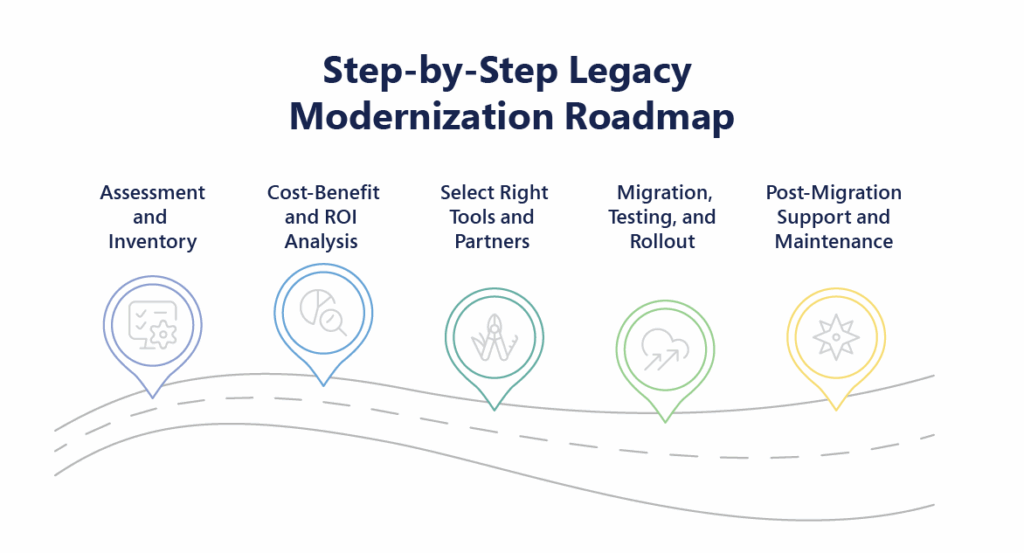
1. Assessment and Inventory of Existing Systems
- Identify all legacy components and dependencies
- Evaluate business criticality, usage, and technical health
- Use tools like Qinfinite’s digital twin capabilities for deeper analysis
2. Cost-Benefit and ROI Analysis
- Estimate direct and indirect modernization costs
- Compare with ongoing maintenance expenses
- Model long-term ROI using metrics like agility gains, user experience improvements, and downtime reduction
3. Selecting the Right Tools and Partners
- Choose modernization platforms
- Look for partners with mainframe, cloud, and data expertise
- Evaluate automation capabilities and post-migration support
4. Migration, Testing, and Rollout
- Use phased or parallel rollout to mitigate risk
- Integrate automated testing for legacy logic (tools like Qyrus)
- Ensure security and compliance validation
5. Post-Migration Support and Maintenance
- Monitor KPIs (latency, uptime, error rates)
- Ensure knowledge transfer and training
- Implement DevOps for continuous improvement
Common Challenges and How to Overcome Them
| Challenge | Mitigation Strategy |
|---|---|
| Data Loss Risk | Dual-run systems, automated validation, rollback testing |
| Downtime Anxiety | Blue/green deployments, sandbox testing |
| Cultural Resistance | Change management, reskilling, transparent ROI stories |
| Integration Issues | API-first design, middleware, CI/CD pipelines |
| Lack of Documentation | Reverse-engineering tools, knowledge capture from SMEs |
| Inflexibility for Innovation | Modular architecture, cloud-native services |
| Executive Misalignment | Business case modeling and visible early wins |
How Quinnox Accelerates Legacy Modernization
Quinnox helps enterprises modernize legacy mainframe systems without disrupting business operations. Powered by Qinfinite, our Intelligent Application Management platform, we enable faster, smarter transformations through:
-
- AI-driven application analysis and code refactoring
- Low-code/no-code modernization accelerators
- API-first integration with cloud and SaaS platforms
- End-to-end visibility, compliance, and automation
With Qinfinite, you don’t just modernize—you gain real business value:
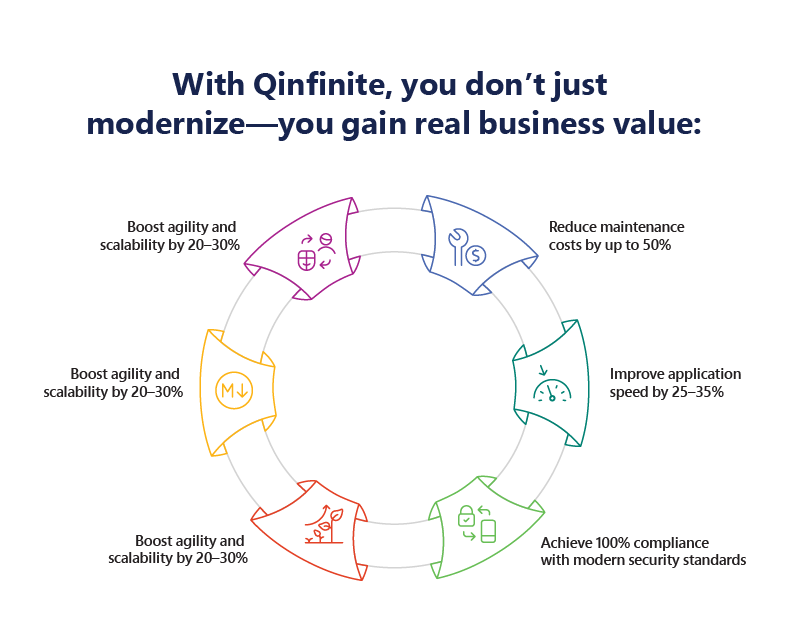
Qinfinite turns legacy into future-ready—efficient, agile, and built for what’s next.
Summary: Is Your Organization Ready for Modernization?

Modernizing legacy mainframes is no longer a back-office concern—it’s a boardroom priority. As cloud-native architectures, AI-driven operations, and digital customer experiences become the norm, clinging to outdated systems risks your organization’s competitiveness, security, and scalability.
That’s where platforms like Qinfinite come in. Powered by AI and built for intelligent application management, Qinfinite helps assess modernization readiness, simulate changes via Digital Twins, and accelerate transformation without disruptions. Whether it’s lift-and-shift, full refactor, or hybrid, Qinfinite ensures your journey is smart, secure, and scalable.
Don’t let outdated technology hold your business back. Schedule a free consultation with our Qinfinite experts to evaluate your current IT landscape, design a tailored modernization strategy, and navigate your transformation journey seamlessly.
1. Streamline Development and Deployment:
- Facilitate the initial design and configuration of agents, including goal definition, algorithm selection, and data source configuration.
- Enable seamless deployment across diverse environments, such as cloud platforms, on- premise servers, and edge devices.
4. Telecommunications
Dynamic Risk Assessment: In telecom, data privacy regulations (like GDPR) are crucial. AI assesses the impact of privacy regulations on customer data handling practices, ensuring compliance without compromising service.
Example: AI helps telecom providers audit data storage practices to align with GDPR, ensuring customer privacy and regulatory adherence.
5. Retail
Automated Policy and Document Updates: Retailers must adapt to consumer protection and employee rights regulations. AI updates internal policies based on regulatory changes, keeping customer interactions and employee practices compliant.
Example: AI generates new training material for customer service teams when consumer rights regulations are updated, ensuring compliance with minimal manual effort.
With iAM, every application becomes a node within a larger, interconnected system. The “intelligent” part isn’t merely about using AI to automate processes but about leveraging data insights to understand, predict, and improve the entire ecosystem’s functionality.
Consider the practical applications:
Real-World Example: Enhancing Customer Service in Finance
Consider a large financial institution seeking to improve its customer service experience. By leveraging Agent Management Services, the institution can:
- Deploy a network of Al-powered agents capable of handling a wide range of customer inquiries, such as account balance inquiries, transaction history checks, and basic support requests.
- Train and optimize these agents to accurately understand customer intent, provide timely and helpful responses, and even anticipate customer needs proactively.
- Ensure the security and compliance of these agents, safeguarding sensitive customer data and adhering to strict financial regulations.
- Continuously monitor and refine agent performance, identifying areas for improvement and making necessary adjustments to optimize the customer experience.
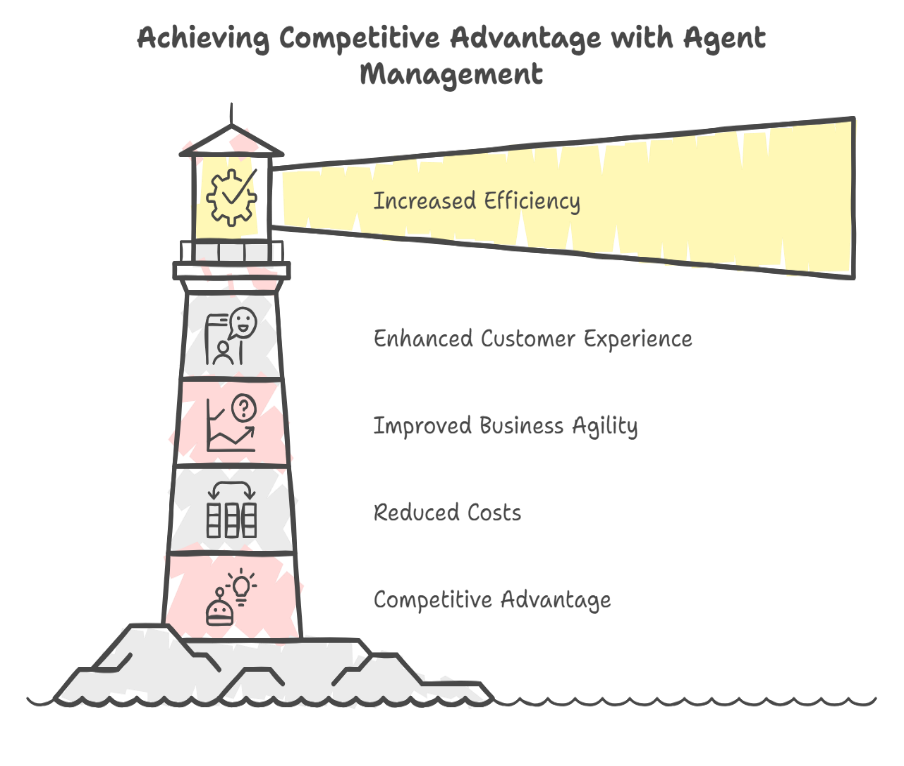
- Increased Efficiency and Productivity: Automating routine tasks and streamlining workflows, freeing up human resources for more strategic initiatives.
- Enhanced Customer Experience: Delivering personalized and efficient customer service, improving customer satisfaction and loyalty.
- Improved Business Agility: Enabling faster response times to changing market conditions and customer demands.
- Reduced Costs: Optimizing resource allocation and minimizing operational expenses.
- Competitive Advantage: Gaining a competitive edge by leveraging the power of Al and automation to innovate and deliver superior products and services.
Conclusion:
The rise of agent-driven systems marks a significant shift in the technology landscape. By embracing Agent Management Services, organizations can navigate this new era with confidence, unlock the full potential of AI, and gain a competitive advantage in the digital age.
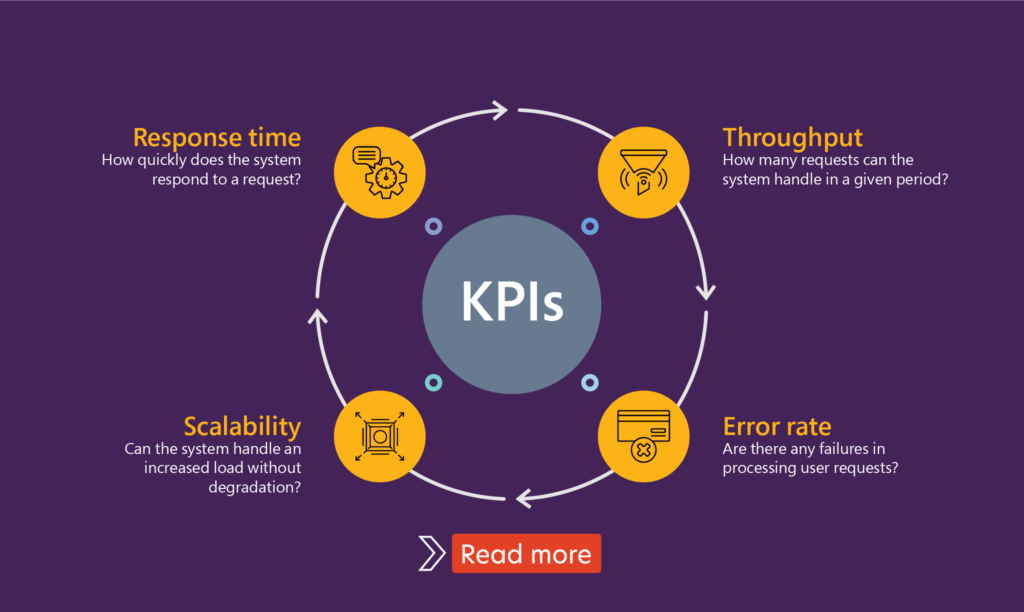
Qinfinite’s Auto Discovery continuously scans and maps your entire enterprise IT landscape, building a real-time topology of systems, applications, and their dependencies across business and IT domains. This rich understanding of the environment is captured in a Knowledge Graph, which serves as the foundation for making sense of observability data by providing vital context about upstream and downstream impacts.
2. Deep Data Analysis for Actionable Insights:
Qinfinite’s Deep Data Analysis goes beyond simply aggregating observability data. Using sophisticated AI/ML algorithms, it analyzes metrics, logs, traces, and events to detect patterns, anomalies, and correlations. By correlating this telemetry data with the Knowledge Graph, Qinfinite provides actionable insights into how incidents affect not only individual systems but also business outcomes. For example, it can pinpoint how an issue in one microservice may ripple through to other systems or impact critical business services.
3. Intelligent Incident Management: Turning Insights into Actions:
Qinfinite’s Intelligent Incident Management takes observability a step further by converting these actionable insights into automated actions. Once Deep Data Analysis surfaces insights and potential root causes, the platform offers AI-driven recommendations for remediation. But it doesn’t stop there, Qinfinite can automate the entire remediation process. From restarting services to adjusting resource allocations or reconfiguring infrastructure, the platform acts on insights autonomously, reducing the need for manual intervention and significantly speeding up recovery times.
By automating routine incident responses, Qinfinite not only shortens Mean Time to Resolution (MTTR) but also frees up IT teams to focus on strategic tasks, moving from reactive firefighting to proactive system optimization.
Did you know? According to a report by Forrester, companies using cloud-based testing environments have reduced their testing costs by up to 45% while improving test coverage by 30%.
FAQs Related to Legacy Mainframe Modernization
Mainframe modernization is the process of updating legacy systems to work with modern technologies—like cloud, APIs, and microservices—without disrupting core operations.
In 2025, it’s crucial due to rising costs, outdated technologies, cybersecurity risks, and the shortage of skilled legacy developers. Modernization enables agility, cost savings, and digital innovation.
Common strategies include:
Rehosting: Lift-and-shift to new platforms
Replatforming: Move to modern infrastructure
Refactoring: Rewriting code in modern languages
Rebuilding/Replacing: Using SaaS or microservices
Hybrid: Combining approaches for flexibility
Challenges include:
Risk of data loss or downtime
Integration complexities
Cultural resistance to change
High costs without clear ROI
Limited visibility into legacy systems
Readiness starts with:
A complete inventory of systems
Clear business goals
ROI modeling
Leadership alignment
The right tools, partners, and governance framework
